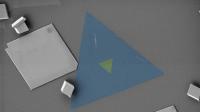In search of new materials technologies for electronics

Two-dimensional semiconductor - tungsten disulfide (colored triangles) on a silicon substrate, photo by Jakub Sitek (photo taken with an electron microscope)
The project of Professor Mariusz Zdrojek from the Faculty of Physics was awarded funding from the National Science Centre within the competition PRELUDIUM BIS 5. The scientist, with a PhD student, will deal with synthesis of 2D semiconductors for innovative applications in electronics.
To keep up the present global trend of miniaturisation of electronic, photonic and sensor devices, we need new materials technologies – emphasises Prof. Mariusz Zdrojek. – A new option in the search for materials of a few nanometres’ thickness are 2D materials – he adds.
The aim of the project ”Scalable, low-temperature synthesis of 2D semiconductors for innovative applications in electronics” is to solve the problem of synthesis of 2D materials in high temperatures and to propose an alternative strategy of “responsible” growth, meeting the new scientific and technological needs.
– We wish to develop a low-temperature technology based on MOCVD, so the technology of deposition of thin layers on materials surfaces through application of metalo-organic compounds in the form of vapour – says Prof. Mariusz Zdrojek. – The technology may provide various 2D semiconductors on bases compatible with the needs of the industry, of quality comparable with this obtained through high-temperature processes – he explains.
Understanding growth mechanisms will help to better control the process and upgrade synthesis protocols and materials quality. This is a step towards better electronic devices, unlocking presently unavailable applications and decreasing energy consumption in electronics production.
The project is divided into two parts – technological and scientific one, and will end with a demonstration of practical application.
– The technological part aims at production of 2D semiconductor layers with MOCVD at temperatures below 400 degrees Celsius – says Prof. Mariusz Zdrojek. – The scientific part will concentrate on studying growth mechanisms at low temperatures – he adds.
The aim of the PRELUDIUM BIS competition is support for PhD students and funding of research projects completed as part of doctoral dissertations. The research teams consist of only two persons – the supervisor who is project leader and the PhD student.
In the fifth edition of the competition, 229 scientists applied for funding. 43 applicants will receive grants of the total value of almost 26 million Polish złoty.







